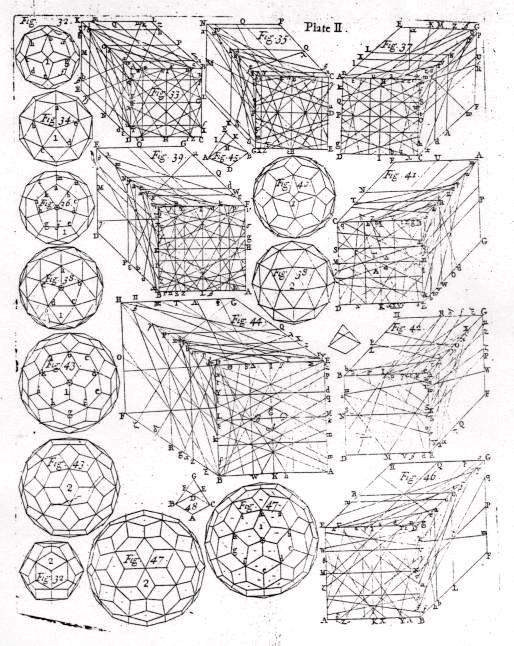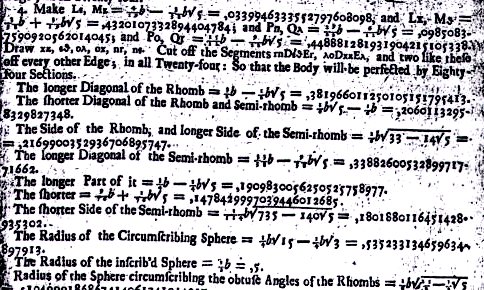Abraham Sharp's Polyhedra
Abraham Sharp (1651-1742) was an astronomer at the English Royal
Observatory. He wrote a book, Geometry Improv'd,
published in 1718, rich in novel polyhedra, especially ones with
tetragonal faces. The book shows how to cut these new solids from
cubes of wood. Plate II of the book gives a flavor of the
complexity of the polyhedra and the necessary cuts:
 The most complex of these has 120 faces. What is most
amazing is that Sharp calculates all the necessary dimensions for
constructing these solids with fifteen to twenty decimal places of
accuracy! Here is a typical section of his text:
The most complex of these has 120 faces. What is most
amazing is that Sharp calculates all the necessary dimensions for
constructing these solids with fifteen to twenty decimal places of
accuracy! Here is a typical section of his text:
 For three reasons, I list him here as an artist
of polyhedra. Firstly, the solids which he constructed are
of no special mathematical value; they are not models of anything
other than themselves. They are purely aesthetic objects,
geometric sculptures which he is sharing with us so we can enjoy
their forms. Secondly, the plates are "neatly engraved by
his own hands". (Imperial Encyclopedia, 1812, "Sharp,
Abraham".) And thirdly, as an astronomer, he well knew that
there was no earthly reason to work out this many significant
digits. It is far beyond what is needed or usable in
construction. He clearly wrote this book out of a love for
the beauty of geometry.
For three reasons, I list him here as an artist
of polyhedra. Firstly, the solids which he constructed are
of no special mathematical value; they are not models of anything
other than themselves. They are purely aesthetic objects,
geometric sculptures which he is sharing with us so we can enjoy
their forms. Secondly, the plates are "neatly engraved by
his own hands". (Imperial Encyclopedia, 1812, "Sharp,
Abraham".) And thirdly, as an astronomer, he well knew that
there was no earthly reason to work out this many significant
digits. It is far beyond what is needed or usable in
construction. He clearly wrote this book out of a love for
the beauty of geometry.
Addendum: Several decades after writing the above, I looked
deeper into Sharp's work, cut some of his designs from wood, made
a video about him, and wrote an in-depth paper about his work. See
this page.



